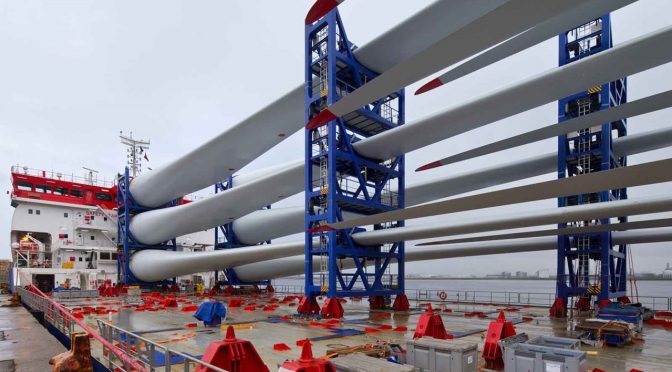The Global Wind Blade Supply Chain Update 2020 marks GWEC Market Intelligence’s second key component assessment, which is part of the GWEC Market Intelligence service that provides insights and data-based analysis on the development of the wind industry.
Blades are one of the most critical and expensive components of a wind turbine, and having the right supply chain strategy is crucial for all wind turbine manufacturers. The right supply chain strategy is also key to ensure that the world can deploy wind power at the necessary rate and in new markets to meet decarbonisation goals and keep global warming below 1.5°C.
To fulfil a growing demand for wind power across the world, there are two main ways that wind blades are manufactured and sourced for projects: in-house manufacturing by turbine OEMs and vendors, and independent manufacturers that specialise in blades.
As of today, wind blade manufacturing has expanded from its home in Europe to North America, Asia, Latin America and, to a lesser extent, Africa and the Middle East. According to the report, there are currently 15 turbine vendors producing around half of the global demand for blades with in-house blade facilities. The remaining demand is met by around 20 independent blade manufacturers in 14 countries across four continents. Overall, the number of blade suppliers has decreased by one-third since 2016 due to market consolidation as small and medium-sized manufacturers are unable to compete in cost, R&D investment, and global footprint.
While this manufacturing capacity is sufficient to meet current wind market forecasts up to 2024 almost two times over, other factors such as technology innovation, pressure to reduce costs, the COVID-19 crisis, and ambitious long-term onshore and offshore wind targets will impact the development of the global wind blade supply chain going forward.
Ben Backwell, CEO at GWEC commented: “Supply chain strategies in the wind industry have continued to evolve to meet changing market conditions and to reduce costs. As more and more countries transition away from support mechanisms such as Feed-in-Tariffs to auction schemes, cost reduction has become the top priority for turbine manufacturers, especially as they enter new emerging markets. As a result, we are seeing the outsourcing of blade production to independent manufacturers becoming increasingly popular, continued momentum towards market consolidation, as well as innovation in design and materials used in blade production to reduce costs and extend the global footprint of manufacturers”.
As supply chain strategies have evolved for blade manufacturers, so have the blades themselves. Over the last decade, longer wind blades have made turbines far more efficient, allowing asset owners to harness more wind resource, and helping to reduce the levelised cost of electricity (LCOE) for wind power across the world.
From a design perspective, there has been a trend towards optimising blade structures and using more carbon fibre reinforcement in blades beyond 50 m in length, which is especially true for oversized offshore wind blades. To control the cost of expensive carbon fibre, leading suppliers have also been developing and adopting hybrid materials into their models. Over the past few years, there has also been a shift towards materials that reduce manufacturing cycle times and energy consumption such as thermoplastic materials, which can also facilitate end-of-life blade recycling.
In addition, the uptake of a segmented blade design is expected to grow as turbine rotor sizes continue to increase. To maximise energy generation and reduce the cost of maintenance, more digital solutions are also expected to be introduced to the wind industry such as Blade Condition Monitoring Systems (BCMS), robotics and drones, smart erosion control solutions, and more.
Feng Zhao, Strategy Director at GWEC said: “As turbines become bigger and bigger, manufacturers are innovating blade designs to manage CAPEX of projects, improve on logistics, as well as find solutions for more sustainable end-of-life decommissioning. Considering that the number of turbines decommissioned will triple in 2030 compared to current levels, innovating blade designs to provide sustainable recycling options should be a key priority for the industry”.
“It is also crucial for manufacturers to transition their manufacturing lines now to prepare for larger blades in the future and avoid any potential bottlenecks. This is especially important as offshore wind growth picks up speed over the next decade, as offshore wind projects already require significantly larger blades. Although leading blade producers are confident that they can meet a growing demand from a technology point of view, greater long-term pipeline visibility is needed for manufacturers to invest in new facilities and increase their production capacity now to meet future demand”, he added.
The trends and innovations highlighted in the Global Wind Blade Supply Chain Update 2020 are the result of effective collaborative between government laboratories, academia, and industry, with a focus on long-term value creation backed by knowledge exchange. With more investment in research and innovation as well as greater market certainty, even more opportunities for wind power across the world can be unlocked to help reach the world’s decarbonisation goals quicker, cost-effectively, and sustainably.
Learn more insights in the full report, available exclusively for GWEC Members on the Market Intelligence Platform here.


